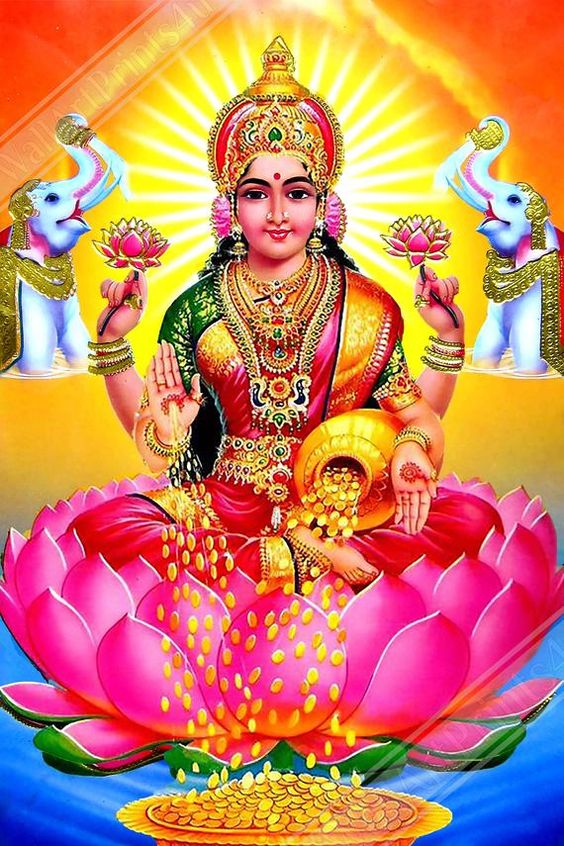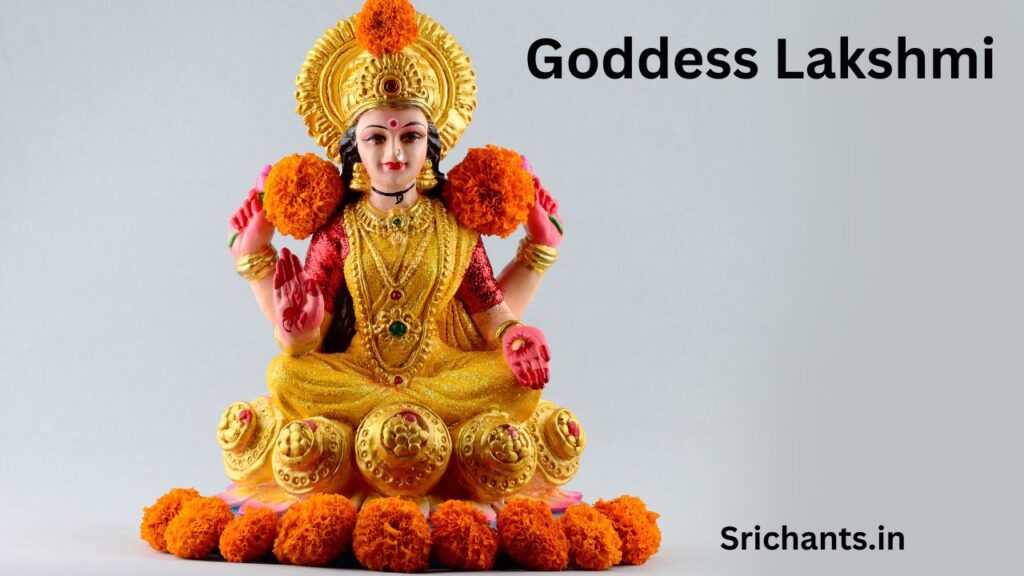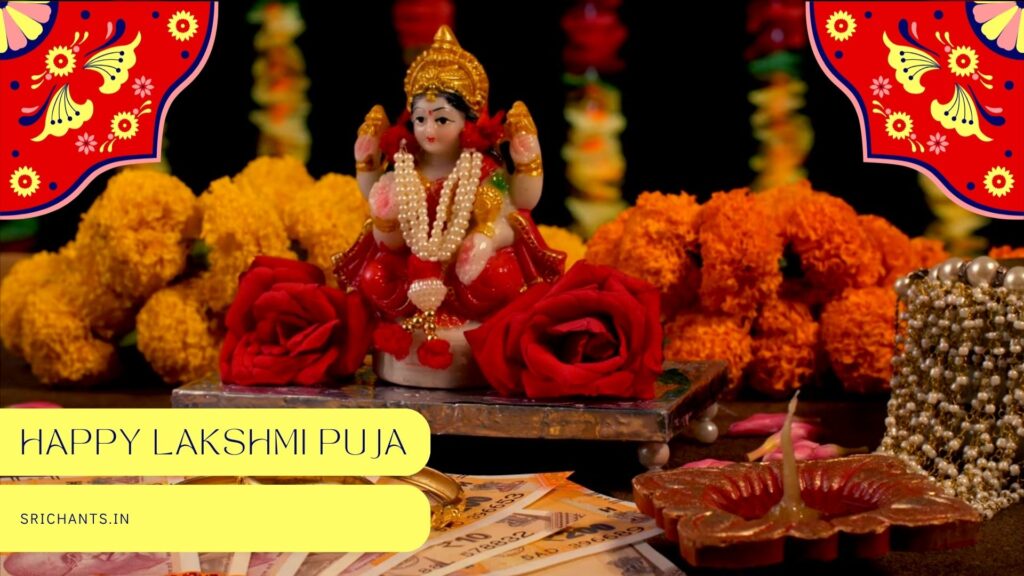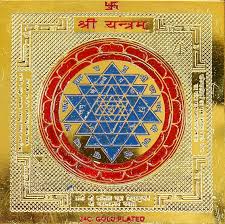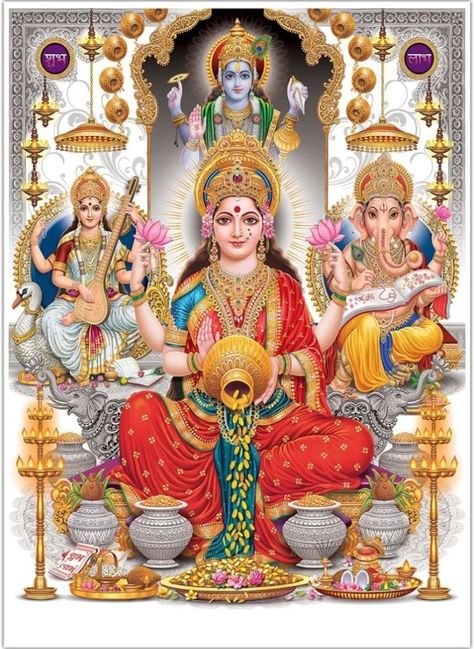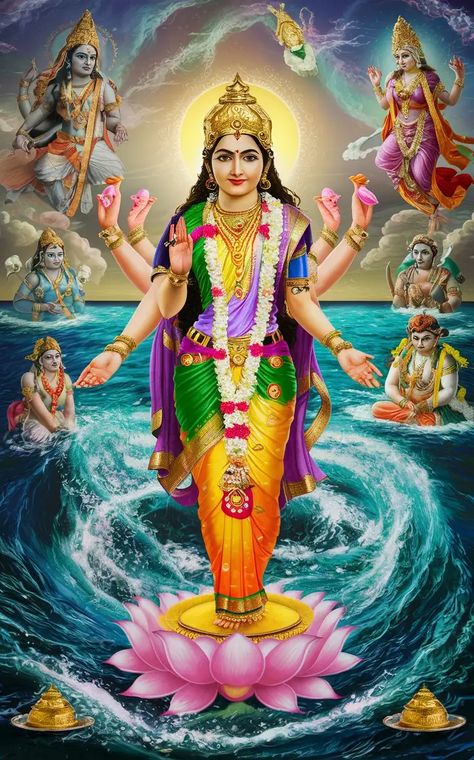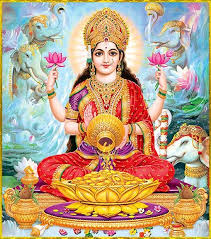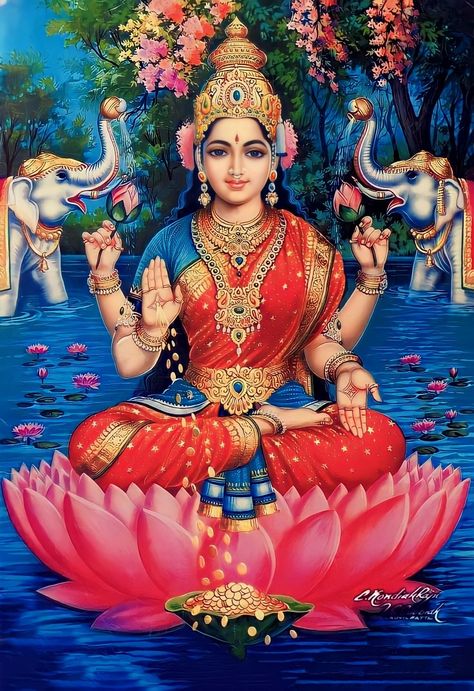Symbol Of Laxmi : Lakshmi’s Attire and Adornments
Introduction
Within the colorful fabric of Hindu mythology, the Goddess Lakshmi is a highly regarded representation of wealth, beauty, and heavenly female power. Lakshmi’s iconography, as the spouse of Lord Vishnu, the universe’s protector, is rich in symbolic meaning; every piece of her clothing and accessories has deep spiritual importance.
Examining the fine points of Lakshmi’s artistic depiction, we find an engrossing story that highlights the complex character of this beloved goddess. From the brilliant colors of her clothing to the glittering decorations on her body, every part of Lakshmi’s appearance acts as a channel for the gifts and qualities she bestows upon her followers.
We learn more about the divine feminine forces Lakshmi represents and the important lessons she teaches on the way to both material and spiritual fulfillment by delving into the symbolic language of her clothing and jewelry. Come explore the secrets woven into the very fabric of the Goddess Lakshmi with us.
The Vibrant Colors of Lakshmi’s Cloaks
Deliberate manifestations of the holy attributes that the Goddess Lakshmi embodies, the vivid colors that adorn her clothing are not just aesthetic decisions. Warm reds and pinks are among the most well-known colors connected to Lakshmi and have great meaning in Hindu mythology.
Reluctant Red
Red is a color signifying passion, energy, and the life-giving power of the divine feminine; it is frequently shown as Lakshmi’s saree or shawl. This color is thought to stand in for the Goddess’s capacity to kindle in her followers a spark of creativity, wealth, and plenty. In keeping with Lakshmi’s position as the giver of both material and spiritual nourishment, the deep crimson tones represent the rich, fertile soil that supports the growth of all life.
Gentleness of Pink
Lakshmi’s clothing’s delicate pink hues, which balance the blazing crimson, represent the Goddess’s kindness, grace, and nurturing qualities. A calming counterpoint to the vibrant intensity of the red, this pastel hue portrays the kind, loving aspect of the divine feminine. Pink is thought to have soothing, gentle tones that correspond with the Goddess’s capacity to foster love, harmony, and inner tranquilly in her followers.
Alchemy of Color
The way that Lakshmi’s clothes blends pink and red harmoniously symbolizes the harmony and balance that she exude. When these complimentary colors are used together, they produce a visual symphony that refers to the Goddess’s function as the personification of the divine feminine, able to contain both the fiery and the tender sides of woman. This chromatic harmony reminds us that we may only experience real wealth and prosperity when we harmonize the masculine and feminine forces within of ourselves.

Skin Radiance of Lakshmi
Many times, Lakshmi is shown in iconography with a brilliant, golden-hued complexion that exudes an unearthly beauty. This heavenly radiance represents the Goddess’s divine nature and the spiritual light she gives her followers, not just a physical quality.
Understanding the Golden Hue
It is thought that Lakshmi’s skin glows golden in reflection of her position as the pinnacle of wealth, prosperity, and the purest kind of virtue. This brilliant skin is connected to the sun, a heavenly body that represents the universe’s constant richness, knowledge, and divine light. Thus, the Goddess’s brilliant brilliance is considered as a material representation of the material prosperity and spiritual enlightenment she can bestow to those who revere her.
Relationship with Lotus
In Hindu and Buddhist traditions, Lakshmi’s golden skin is sometimes compared to the delicate petals of the lotus flower, a holy emblem. The lotus is a symbol of spiritual enlightenment, purity, and the capacity to rise above the material world. It blooms in the muck but stays pure. Making this connection, Lakshmi’s golden complexion becomes a monument to her own heavenly purity and her ability to lead her followers toward spiritual enlightenment even in the face of obstacles from the material world.
Inner Beauty Radiance
The radiant complexion of Goddess Lakshmi is a reflection of her inner brilliance and the spiritual attributes she embodies as much as a physical feature. It is thought that her compassion, knowledge, and heavenly grace that she bestows onto her followers are manifested in this heavenly brightness. Her followers are motivated to develop their own inner beauty and strive to match the qualities of the Goddess—kindness, generosity, and spiritual enlightenment—as they come into contact with Lakshmi’s bright essence.
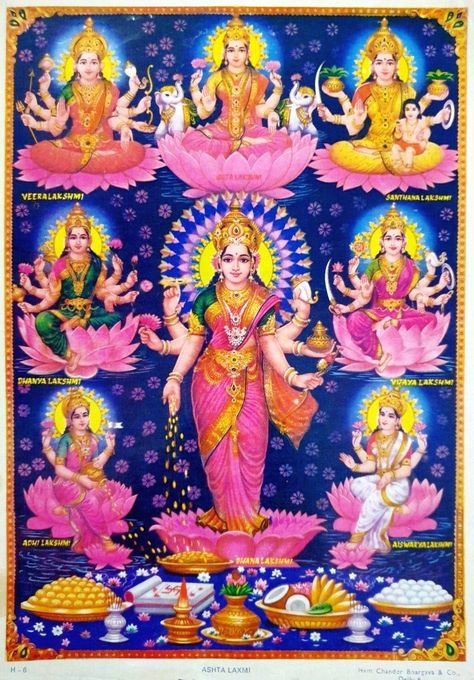
Elegant Lotus Throne of Lakshmi
Her elegant seated position atop a lotus blossom is among Lakshmi’s most recognizable features. Deeply symbolic, this depiction links the Goddess to the divine feminine, spiritual enlightenment, and purity.
Purity Symbolism in the Lotus
A potent metaphor for the human path to enlightenment is the lotus flower, which can rise from the muck and bloom in perfect beauty. Lakshmi is a living example of how to leave the worldly world and reach a condition of spiritual purity as she sits on this holy blossom. Mirroring the Goddess’s own heavenly nature, the lotus is unaffected by the dirt from which it grows.
Lotus and Divine Feminine
Additionally representing the heavenly feminine principle is the lotus throne on which Lakshmi is seated. Often compared to the womb, the flower’s elegant, cupped petals stand for the Goddess’s function as the originator of all life. By seated on this hallowed vessel, Lakshmi declares her place as the personification of the divine feminine, the nourishing and generating power that keeps the cosmos going.
Lotus and the Awakening of Spirit
Furthermore potently representing spiritual awakening and enlightenment is the lotus. Sitting calmly on this celestial blossom, Lakshmi stands for the achievement of the highest level of consciousness, when the devotee connects with the divine and transcends the bounds of the material world. The Goddess’s lotus throne so becomes a visual metaphor for the path to self-realization, in which the person, like the lotus, rises from the muck of material attachments to blossom in the brilliant light of spiritual knowledge.
The Meaning of the Jewels Lakshmi Wore
The ornaments that cover the figure of Goddess Lakshmi are more than just ornamental features; each one symbolizes a different facet of her heavenly personality and the favors she bestows upon her followers.
What Gold Means
Many times, Lakshmi is shown donning an overabundance of gold jewelry, including bracelets, anklets, and elaborate necklaces and earrings. Hindus honor this valuable metal as a symbol of the sun, the ultimate source of light, prosperity, and wealth. By wearing gold, Lakshmi declares herself to be the personification of these heavenly qualities and assures her followers of both temporal and spiritual wealth.
Why Gemstones Matter
Lakshmi is decked up with a range of gemstones, each with a special symbolic meaning, in addition to her golden jewelry. For example, diamonds are said to represent the purity and visual clarity that the Goddess grants her followers, enabling them to perceive the divine in the corporeal world. The Goddess’s active, life-giving energy is symbolized by rubies, and her worshipers’ lives may be filled with fertility and lush richness through emeralds.
Motif Lotus
A common motif in Lakshmi’s iconography, the lotus flower is frequently included into her jewelry as well. Lotus-shaped earrings, necklaces, or bracelets may be worn by Lakshmi, therefore enhancing the symbolic links between the Goddess, the holy blossom, and the ideas of purity, spiritual enlightenment, and divine feminine strength.
Symbolism of Dress
Putting these lavish accessories on Lakshmi is not just a decorative exercise; it is a rite that recognizes the Goddess’s heavenly position and the respect her followers have for her. By adorning the Goddess with these symbolic gems, the devoted hope to call forth her favors and convey their love and ambition to live up to the attributes she stands for.
Elegant Goddess Posture
Not just a product of artistic convention, but also a conscious depiction of the Goddess’s divine attributes and the spiritual lessons she teaches her followers, Lakshmi is frequently shown in a beautiful, calm stance.
Understanding the Padmasana Posture
The Padmasana, or lotus position, is among the most often linked poses to the Goddess Lakshmi. Reaching inner tranquilly, equilibrium, and spiritual enlightenment is symbolized by this cross-legged, contemplative position. In this way, Lakshmi represents the ideas of self-reflection, mindfulness, and the harmonious blending of the material, mental, and spiritual domains.
Poetry and Composition Symbolism
When Lakshmi sits on her lotus throne, her calm, composed manner reflects her inner peace and the tranquilly she wants to instill in her followers. With all of the ups and downs of the corporeal world, the Goddess is able to remain focused and grounded. Following Lakshmi’s elegant manner encourages her followers to cultivate the mental and emotional strength required to gracefully and steadfastly negotiate life’s uncertainties.
The Banning Gesture
Furthermore loaded with deep symbolic meaning are Lakshmi’s hand gestures, called mudras. Frequently shown in one of Lakshmi’s hands, the Abhaya mudra, a hand gesture representing protection and fearlessness, represents her role as a kind, protective deity who gives her followers the confidence and security to overcome life’s challenges. In a similar vein, the Goddess is ready to reveal her devotees both financial and spiritual wealth as seen by the Varada mudra, a hand motion that stands for the bestowing of boons and favors.
Why Lakshmi’s Attendants Matter
Two elephants, which have great symbolic meaning in Hindu tradition, frequently accompany the Goddess Lakshmi in her iconography.
Elephant-Symbolism
Lakshmi’s flanking elephants are said to stand for power, aristocracy, and the many blessings of nature. Elephants, being strong, magnificent animals, stand in for the Goddess’s capacity to give her followers the material, mental, and spiritual resources they need to prosper.
The Elephants as Providers of Plenty
Elephants are linked in Hindu mythology to prosperity and plenty. Many times, the elephants standing next to Lakshmi are seen pouring water over the Goddess, signifying the Goddess’s ability to bestow both material and spiritual riches upon her followers. This graphic metaphor emphasizes Lakshmi’s position as the giver of all kinds of plenty, from worldly goods to spiritual sustenance.
Protector Elephants
Additionally signifying their function as guardians of the Goddess and her followers, elephants appear in Lakshmi’s iconography. Elephants are considered as living, breathing examples of the Goddess’s capacity to protect her devotees from both material and spiritual damage. Lakshmi’s devotees, who look to her supernatural assistance and direction in negotiating the difficulties of the mundane world, are comforted and trusted by her symbolic image.
The Lakshmic Celestial Associations
Celestial links that link Lakshmi to the rhythms and energy of the universe enhance her divine iconography even more.
What the Lotus Means
Deeply ingrained in Hindu theology, the lotus flower, which acts as Lakshmi’s throne, stands for the link between the divine and the earthly realms. A lotus emerging from the muck represents the Goddess’s capacity to transcend the earthly realm and lead her followers to spiritual enlightenment.
Planetary Energy Effects
Additionally intimately related to the forces of the heavenly bodies, especially Venus, is Lakshmi’s iconography. Known as the planet of wealth, beauty, and love, Venus is said to control the blessings of the Goddess Lakshmi. Because of her connection to Venus, Lakshmi is furthered as the personification of the divine feminine and provides her followers with the chance to harmonize with the harmonious, life-affirming powers of the universe.
Understanding Lucky Days
Fridays, for example, are seen to be particularly lucky days for paying respect to and calling upon the Goddess Lakshmi. This relationship to the week’s rhythms illustrates how the Goddess can affect the ups and downs of material and spiritual prosperity in the lives of her followers.
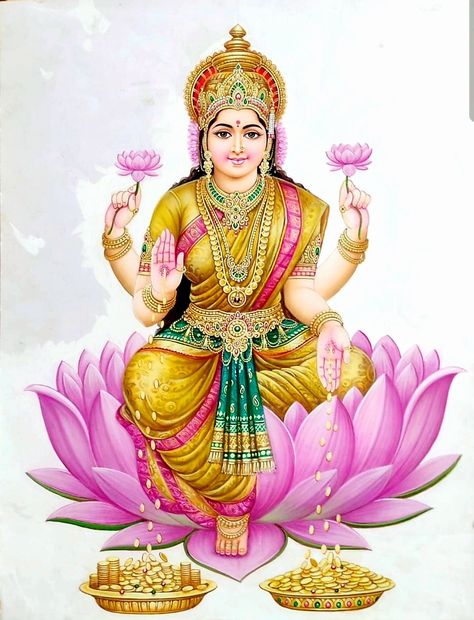
The Transformational Potential of Blessings from Lakshmi
A deep invitation to a life-changing path of spiritual and material fulfillment is extended to her believers by the holy iconography and symbolic meanings woven into her clothing and ornaments.
Building Inner Beauty
Lakshmi’s devotees are motivated to develop their own inner beauty and identify with the Goddess’s characteristics of compassion, generosity, and spiritual enlightenment by copying her brilliant, golden complexion and the grace of her stance. Through this self-examination and personal development process, people are able to connect with the divine feminine energies that Lakshmi stands for and transcend the bounds of the material world.
Prosperity and Plenty Manifestations
A potent reminder of Lakshmi’s capacity to bestow worldly and spiritual richness upon her devotees, the Goddess’s jewelry is associated with money, prosperity, and the cosmic forces. Invoking her blessings and lining up with the flow of wealth in the material and metaphysical domains, people can honor the Goddess and include her symbolic ornaments into their life.
Building Courage and Fortitude
The Goddess’s ability to provide her followers the bravery, protection, and heavenly gifts required to overcome the obstacles of the corporeal world is symbolized by her hand gestures, notably the Abhaya and Varada mudras. Through a connection with these symbolic actions, people can develop the inner fortitude and resiliency needed to get beyond challenges and realize their greatest goals.
Closing: Accepting the Gifts of Goddess Lakshmi
From the colors of her clothing to the ornaments that cover her figure, the Goddess Lakshmi’s iconography is rich with symbolism that powerfully invites her followers to accept the divine feminine energies she stands for. Through an awareness of the deeper implications of Lakshmi’s visual representation, people can align themselves with the ideals of wealth, beauty, and spiritual enlightenment and so unlock the transforming power of her blessings.
Entering the enthralling realm of Lakshmi’s symbolic language, we are brought back to the deep knowledge and direction the Goddess bestows to people who seek her favor. Every aspect of Lakshmi’s visual representation, whether it be the brilliant glow of her golden complexion, the calm poise of her lotus-throne posture, or the celestial associations that permeate her iconography, opens a door to the Goddess’s infinite compassion and her steadfast dedication to the welfare of her devotees.
Honoring the Goddess Lakshmi and integrating the symbolic meaning of her clothes and accessories into our life can help us to develop a closer relationship with the divine feminine and open the doors to material success, spiritual enlightenment, and the achievement of our greatest goals. As we accept the gifts of the Goddess, we are given the ability to change ourselves, our lives, and the world around us, so bringing us into harmony with the endless abundance that Lakshmi so kindly bestows and the harmonic rhythms of the universe.
#lakshmi #lakshmilotus #lotus #gifts #goddesslakshmi
